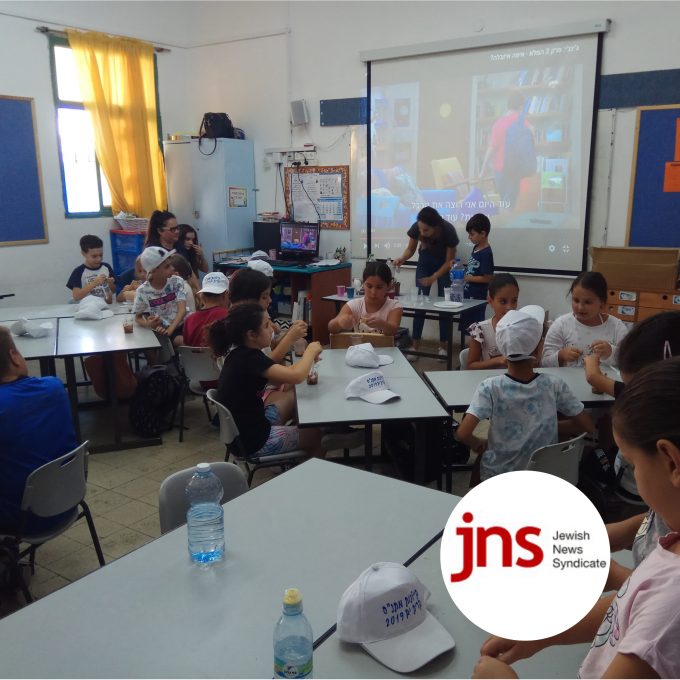4 November 2009 Kadima Madas moveable feast of science World ORT is luring Israeli kids back to studying science with the creation of five mobile, interactive exhibitions, each one illustrating a principle of physics. Launched at Kiryat Yam on Monday, Mada-Na is Phase 10 of World ORTs groundbreaking Kadima Mada programme, which has seen major investments in the technological infrastructure and teacher training at high schools in more than 30 municipalities throughout Israel. The exhibitions, which together comprise a Mobile Science Museum, were designed and developed by Danny Ovadiah, a co-recipient of last years Beatrice Wand-Polak award given by World ORT to outstanding educators, to attract students to what is an unglamorous field. I was attracted to physics only after experiencing it, because its hard to get excited over theories, Mr Ovadiah told Haaretz. As a young teacher I used to take my childrens toys and build models to prove to students that the laws of physics work Youth are attracted to the arts, cinema and media and look for subjects with glamour. Physics requires investment and effort so people recoil from it. World ORTs Kadima Mada programme is encouraging young Israelis to study science. The physics teacher at Misgav High School has developed 75 installations 15 for each exhibition which demonstrate mechanics, waves, optics, electricity and magnetism, and liquids and gases. The exhibitions have been installed in the Eshkol Payis communal science and art buildings in the peripheral municipalities of Kiryat Yam, Nesher, Tirat HaCarmel, Misgav and Maale Yosef each one adjacent to a school which participates in Kadima Mada. Mr Ovadiah trains teachers in each of the school who then train older science students to serve as instructors. These students then show younger students from local junior high and primary schools how to use the displays. Instruction handbooks are being prepared by Mr Ovadiah, who has written four physics text books in his 23-year career, together with Professor Dan Shechtman, a member of Kadima Madas Academic Advisory Council. Every six months, after hands-on use by students and the general public, the exhibitions will rotate between the five municipalities. The project grew out of a meeting with the directors of the Eshkolot Payis in the countrys north initiated some 18 months ago, said Kadima Mada Executive Director Rony Kalinsky. It became obvious to all present that we were members of a group with similar goals and abilities a group that can work together, Mr Kalinsky told the launch ceremony at Kiryat Yam. And so was born this mutual project to transform scores of complicated physics laws into something tangible, visible and friendly for students and teachers alike Based on the results of our evaluation process, we hope to expand this pilot phase by developing more exhibitions and incorporating more Eshkolot Payis. Hundreds of hours and hundreds of thousands of shekels have been invested in this project which is now, literally, in your hands. Professor Shechtman, who is Philip Tobias Professor of Materials Science at the Technion Israel Institute of Technology, praised the exhibition. I think that the educational concept is good and that the build-up of the displays is very nice and neat, he said. Hopefully this project will motivate students into becoming young scientists instead of lawyers and dentists. Three of Israels nine Nobel Prize winners have been scientists, the latest being Ada Yonath who this year became the first female recipient of the chemistry prize in 45 years. However, there are fears that Israels disproportionately strong scientific performance may not last much longer. According to Haaretz, less than 10 per cent of Israeli children study physics at school and even fewer continue studying it at university. Mr Ovadiah, who is also Director of the Eshkol Payis in Misgav, said: In some places principals dont even open a physics class because the matriculation exam average is low, equipment costs are high and few students enrol. Principals prefer social science classes which, apart from a teacher, demand no investment. He blamed the situation on budget cuts which have reduced the funds available for physics instruction and laboratories. Once theres no budget, there are no labs, the equipment wears down and theres no money to visit the Science Museum. Thats why I wanted to bring the exhibitions to the periphery, to expose students to physics and attract them to study it. It is the heart of science. It is a situation which World ORT, together with its partners in the local municipalities and the Ministry of Education, is keen to reverse. The Mayor of Kiryat Yam, Shmuel Sisso, said his town was already feeling the positive effect of the fruitful partnership with Kadima Mada. We are glad to be the first location to inaugurate a mobile science museum, Mayor Sisso said. It will enable our children to use their own hands, eyes and ears to understand the physics that they learn in the classroom.

Kadima Madas moveable feast of science
04.11.09




